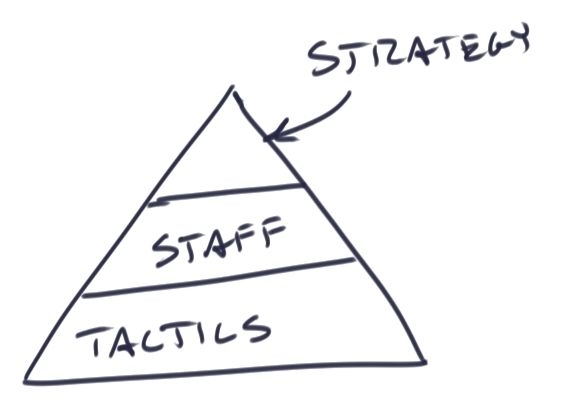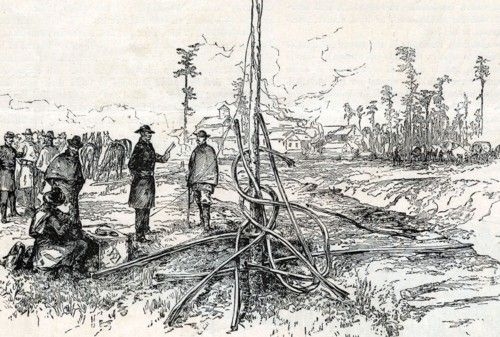Scale and Scaling of DSTO

One of the reasons I don’t agree with the logic of depicting strategy and tactics as a pyramid is the idea that strategy belongs in the executive suite and tactics on the floor. The pyramid structure ignores how doctrine, strategy, tactics, and operations can scale up and down an organization, and it ignores how you can observe all four components at work in the boardroom and the break room.
Let me use a military situation to illustrate. Let’s assume the doctrine of the battle is total war, and everything is on the table for attack. That means that civil infrastructure is just as open to attack as military infrastructure. The way Sherman waged total war, the railroads were a strategic target—block the transport of men and materials, and the Confederate army would have a harder time fighting the war. So Union troops not only tore the rails from the ties, but also used the ties to build fires hot enough to heat the rails. They then twisted the rails around trees into what were called Sherman’s Neckties. The doctrine was to attack all parts of the enemy. The strategy was to hamper all transport. The tactic was to destroy the railroad infrastructure. The operations removed and twisted the rails around trees.
 While different tellings of Sherman’s March to the Sea level differing accusations that Federal troops committed atrocities against the civilian population, Sherman was clear in his orders that the total war aspect of his campaign be directed at the war-fighting and economic infrastructure of the Confederacy, including the cotton gins and railroads, but the food stocks were off limits. Not all field commanders followed Sherman’s command about the food, but many did. Still, in the March to the Sea, the burning of barns, factories, and fields was rare. Napoleon faced a very different situation in his march through Russia. The retreating Russians scorched the earth in front of Napoleon’s advancing army, preventing the attackers from feeding off the land.
While different tellings of Sherman’s March to the Sea level differing accusations that Federal troops committed atrocities against the civilian population, Sherman was clear in his orders that the total war aspect of his campaign be directed at the war-fighting and economic infrastructure of the Confederacy, including the cotton gins and railroads, but the food stocks were off limits. Not all field commanders followed Sherman’s command about the food, but many did. Still, in the March to the Sea, the burning of barns, factories, and fields was rare. Napoleon faced a very different situation in his march through Russia. The retreating Russians scorched the earth in front of Napoleon’s advancing army, preventing the attackers from feeding off the land.
The Allied forces in WWII also engaged in total war, but with discretion in the field. Field commanders had to consider the relative strategic importance of different bridges to decide whether to damage beyond use or destroy. If damaging the bridge was good enough to keep the Germans from using it, then the troops damaged the bridge. If damaging the bridge was not enough, it would be destroyed.
The decisions the field commanders made about the bridges became strategic decisions. In a grand sense, from the viewpoint of Allied command, the decision to take out a bridge was tactical. But in the field, it became a series of local strategies. If making the bridge unusable was a sufficient outcome, the commanders had to make strategic decisions about timing—when to disable the bridge—and decisions about how much to remove. The strategic question of what to remove and when directed the tactics used—where to place the charges, how to set them off, and whether to take action before the enemy arrived or while the enemy was on the bridge.
Scaling in the Boardroom
In the late 1980s, I was part of a strategic planning exercise in a Fortune 500 company. The company had started a five-year strategic planning process about a decade before, when it had started to grow exponentially. As a young man, I not only got the opportunity to observe how senior executives made decisions, but I got to help shape those decisions with the work my team performed, and through the many conversations I had with each senior executive. Over four years, I presented to the steering committee more than 20 times and performed countless operations research projects for just about every senior officer.
At the end all of that work, I realized that within the executive ranks, each officer held different doctrines (beliefs). I realized that each had different strategies that shaped how they thought and how they interacted with the teams and the rest of the steering committee. Each officer used a number of different tactics for communication, both with the research teams and the other officers. They differed in the way they engaged with different individuals, depending on the subject and the situation. One of the biggest take-aways from my time in that company was the way the executives of Mahogany and Walnut Avenue employed DSTO.
During that same period, I watched how the rest of the company approached the officers, and the members of the steering committee. In my first presentation to the steering committee, I sold a complex logistics problem with a single exhibit—nothing more than a piece of information-packed 11 X 16 green-bar paper—in a meeting that took less than 20 minutes. Four years later, nobody presented to the steering committee with anything less than a 40-page deck of slides and a full set of documents in binders, and no one took less than 90 minutes. In those four years the doctrine of presentation changed, as did the supporting strategy, tactics, and operations behind the work.
Most major presentations failed to get steering committee approval. Multi-function taskforces focused on wide-scale data collection, working to present solutions searching for problems. The effort became a series of frustrating exercises, in which the actual percent of project time dedicated to data collection and analysis was less than the effort expended to develop the strategy and tactics of presentation. The presentations attempted to be the next big thing, adding more complexity by attempting to increase the potential for out-of-the park results. This complexity added complications, as some of the suggested changes involved areas that a member of the steering committee might be sensitive about, either protective or antagonistic.
In some cases task force leaders sought out members of the steering committee to pre-schmooze the subject, in an effort to gain support for a presentation. One task force leader believed in this approach so much that The Doctrine of the Schmooze became a cornerstone of his team efforts, with varying degrees of success. Other teams used different presentation tactics to gain favor. While some teams presented with their entire group, one team chose only one person to enter the room and present, supported by an assistant. Most teams used overhead projection slides (in the days before PowerPoint, Harvard Graphics was the dominant presentation software).
During those four years, I think more than 200 people presented to the steering committee. Often I got to watch the other teams; I would be invited by the officers to listen and then help validate the findings of the groups. I got to watch not only the presentations, but the officers of the round table, and how they reacted to the material presented. I could see how doctrine, strategy, tactics, and operations scaled, as each team and each officer deployed a different DSTO, while determining the overall strategy the company would take.
Scaling in the Field
Throughout my career I have watched how stores and distribution centers develop their own DSTO of engagement with the corporate office.
A memory of one distribution operation in particular stands out. There was a change of general managers, in which the new general manager was promoted into his position when the previous GM moved to a new company.
The former GM had maintained an open-door policy; he was open and communicative with the workers on the floor, with the managers in the stores, and with corporate team members. He ran a transparent operation, welcoming outsiders into his facility and openly asking for help from the corporate office. This GM talked freely about their problems, searching for solutions from other DC general managers, engaging with the managers of other distribution centers in his area. People in the operation liked the GM, and his approach to communications with all levels of the facility.
The new GM brought about a stark change. Opacity became the new doctrine. The open reporting stopped. Internal silence or intimidation became a common strategy. In less than 90 days, the culture inside the operations had changed. Department managers and supervisors stopped communicating with outside managers, or did so with pleas for silence about what they were sharing. The GM promoted some preferred managers and supervisors, and even gave managerial authority to hourly personnel with whom he had personal connections. Within six months, several quality department managers, supervisors, and leads had left the company to find new employment, or were let go after standing their ground with the GM.
A new doctrine of opacity and mistrust — “What Happens Here Stays Here” — pervaded the environment. From the outside, other departments in the company measured how performance and effectiveness dropped. If they brought up the issue, the GM countered with data that contradicted the external measurements, but defied systematic verification. The DC team avoided external audit visits as much as they could. When the audit teams did visit, they reported that the general manager or one of three managers was always present, and they did all of the talking. Tactically, the management team ensured that the auditors never spoke one-on-one with employees or supervisors.
The doctrine changed again sharply after the annual inventory at the DC. Company policy dictated that an outside team of finance, accounting, and the auditing accounting firm were required to attend the quarterly inventories. The vice president of operations chose to visit this DC for the year-end audit. The DC general manager was unprepared for the visit. In the audit, the management team was too busy with the audit team to pay attention to the vice president, who decided to take a few employees and inspect the trailer storage yard. Several trailers of undocumented inventory appeared in that casual audit, which prompted the VP to look at more trailers. In the end, a sizable valuation of unprocessed inventory appeared in the yard. Some of the unreceived shipments dated back over six months — shipments from vendors who had claimed shipment and delivery.
While the inventory proceeded inside the building, the vice president asked supervisors and managers questions outside. Without the senior managers present, these supervisors admitted that they had not processed these shipments. One went as far as to show the VP the location of other trailers stored off-property. As the VP spoke to more supervisors, he learned of the doctrine of deceit and opacity.
The general manager was looking for a new job before the end of the day.
Turning the Ship
Within a few weeks, the company hired a new general manager. While it had taken less than six months to create a culture of opacity and deceit, it took over a year for the new general manager to turn the culture of the operation back to a direction of trust-based transparency. The difficulty of developing a new doctrine of trust and developing the strategic commitments to open-door policy and reporting could have been due to any number of factors, including the weakness of the new GM’s leadership. But something more important retarded the speed of change in the distribution center.
The development of doctrine, strategy, tactics, and operations (DSTO) involves all levels of an organization. One of the past GM’s strategies was to punish defiance of the Doctrine of Silence. If a department manager or supervisor resisted the GM’s doctrine, punishment came swiftly and was administered publicly, in front of the rest of the DC management team. Those who could not or would not accept the new doctrine left. Those who remained, learned that breaking with doctrine brought public and private pain. When resistance became futile, a brain and talent drain in the management team resulted.
The new DC GM faced a serious challenge. While he could talk and act following a new doctrine of open transparency, supported with strategic actions of commitment through active listening and praise, it took time for the GM to develop the supportive tactics to put into the operations. Often, the middle layers of management are the developers and testers of tactics. The new GM inherited a cadre of demoralized managers, many of whom held their positions because of their past loyalty to the former GM, not because they possessed the skills and talents to be successful managers.
Even after he was gone, the former GM influenced several of the remaining staff through his personal connections. In an effort to exact revenge on his former employer, he encouraged his supporters to resist the changes implemented by the new GM. After the new GM removed these employees from positions of leadership — or removed them from the facility — the tactical and operations changes required for success quickly took hold. The GM had to seek out people, both external and internal, who were willing to embrace the new doctrine and strategy, and willing to start to build the new tactics of change.
Point of View — Positive Upward Change
"Upward management" is a term often used to describe managing your manager; the idea is that subordinates not only can, but must manage and direct their superiors. To senior managers, upward management is a tactic, a theory that they want subordinates to employ. Changing the viewpoint to that of the middle manager, managing upward is more than a tactic; it becomes a strategy, a commitment to perform in a certain way, or a doctrine stating that success comes from managing the boss.
I once served a client who embraced the notion of managing the boss as a doctrine. This manager believed that the best way to keep his operation on track was to focus on what to say and what to ask for in every conversation with his boss. He learned quickly what the boss wanted to know, what the boss wanted to hear, and what the boss did not want to hear or know about. In fact, this manager made it a point to understand what every executive officer wanted to know, and what he or she couldn't care less about.
This manager used the Doctrine of Managing the Bosses throughout his small organization. He taught his team to embrace the doctrine, and to accept a series of strategic commitments. To make the message clear, this manager had special small posters printed that said:
Managing Your Boss
- Let written reports by others sing our success as time permits. Personally report bad news quickly, and verbally.
- Share the fame, be greedy with the failures.
- Understand what is important to the boss. Know what they always want to know, and what they want to know that minute.
- Don’t make the boss work hard to understand the success. Make failure easy to understand.
- Tell the truth, no matter how mad the boss is.
These five bullet points hung on the cork board at every desk in the department. Watching the team work, it was clear that the culture of the department embraced the doctrine and strategy. This transportation management group operated at a higher level of performance than other departments. The department was not treated differently than other departments in the corporate structure, but other departments envied the recognition the department earned.
After a few years, the doctrine grew upward in the organization. The manager’s boss embraced the doctrine and strategy by teaching it to other parts of his organizational structure. This leader started to manage upward, following the doctrine and strategy. The larger organization tightly embraced the doctrine and strategy, but diverged on the tactics and execution, choosing tactics that best applied to each of the operational areas. Eventually, in about five years, the culture of a major part of the company shifted, embracing the Doctrine of Upward Management. The evidence of that shift was the upward promotion of the entire group of managers, including the promotion of my client to the position of director of operations.
The concept of DSTO scales upward and downward, no matter what level of an organization you work in.



